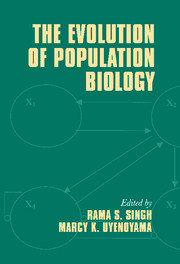Book contents
- Frontmatter
- Contents
- List of contributors
- Publications of R. C. Lewontin
- Preface
- Introduction
- Part I Historical foundations and perspectives
- Part II Genotypes to phenotypes: new genetic and bioinformatic advances
- Part III Phenotypes to fitness: genetics and ecology of populations
- 7 Density-dependent selection
- 8 Nonsynonymous polymorphisms and frequency-dependent selection
- 9 Why k = 4Nus is silly
- 10 Inferences about the structure and history of populations: coalescents and intraspecific phylogeography
- 11 The population genetics of life-history evolution
- 12 Gene–environment complexities: what is interesting to measure and to model?
- 13 Genus–specific diversification of mating types
- Part IV Genes, organisms, and environment: evolutionary case studies
- Part V Applied population biology: biodiversity and food, disease, and health
- Index
7 - Density-dependent selection
Published online by Cambridge University Press: 08 January 2010
- Frontmatter
- Contents
- List of contributors
- Publications of R. C. Lewontin
- Preface
- Introduction
- Part I Historical foundations and perspectives
- Part II Genotypes to phenotypes: new genetic and bioinformatic advances
- Part III Phenotypes to fitness: genetics and ecology of populations
- 7 Density-dependent selection
- 8 Nonsynonymous polymorphisms and frequency-dependent selection
- 9 Why k = 4Nus is silly
- 10 Inferences about the structure and history of populations: coalescents and intraspecific phylogeography
- 11 The population genetics of life-history evolution
- 12 Gene–environment complexities: what is interesting to measure and to model?
- 13 Genus–specific diversification of mating types
- Part IV Genes, organisms, and environment: evolutionary case studies
- Part V Applied population biology: biodiversity and food, disease, and health
- Index
Summary
Introduction
The classical studies of the interplay between natural selection on a character and Mendelian inheritance of variant traits employed simple models, which in essence are those used in most introductory texts on population genetics. Those models therefore form the common reference in discussions of the genetical effects of selection. In their classical models Fisher (1922) and Haldane (1924, 1932) formulated the effect of selection in terms of constant individual fitnesses in a population that reproduces by random mating (Ewens 1979), a situation that mirrors the action of zygotic selection in a random mating population with nonoverlapping generations (Christiansen and Prout 2000). These models form the root of a proliferation of theories incorporating a variety of genetic phenomena, theories that give to the population a genetic description of the action of natural selection (Crow and Kimura 1970, Ewens 1979, Christiansen 1999, Bürger 2000).
Changes in the physical environment can be studied by simply changing the fitness values in time or space, and the methods from the classical analyses are readily adapted to accommodate this extension (Haldane 1948, Haldane and Jayakar 1963). The dependence of individual fitness on population composition, usually referred to as frequency-dependent selection, requires more profound alterations in the models.
- Type
- Chapter
- Information
- The Evolution of Population Biology , pp. 139 - 155Publisher: Cambridge University PressPrint publication year: 2004

